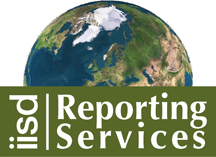News * Abou us * the ENB team * DONATE * Activities * Search * IISD RS home * IISD.org * RSS * What is RSS? * Links |
|
MEA Bulletin
16 January 2007 EUROPEAN COUNTRIES START COMMON WORK UNDER THE PROTOCOL ON WATER AND HEALTH TO IMPROVE WATER MANAGEMENT AND CURB WATER-RELATED DISEASES By Francesca Bernardini, United Nations Economic Commission for Europe (UNECE), and Roger Aertgeerts, Regional Office for Europe of the World Health Organization (WHO) Full article The first meeting of the Parties to the Protocol on Water and Health to the Convention on Protection and Use of Transboundary Watercourses and International Lakes will be held in Geneva from 17 to 19 January 2007.The meeting is organized by the United Nations Economic Commission for Europe (UNECE) and the WHO Regional Office for Europe, which are jointly servicing the Protocol, an innovative set up for multilateral environmental agreements. The Protocol was adopted and signed by 36 countries at the third Ministerial Conference on Environment and Health, London, 1999. It entered into force in August 2005 and to date it has been ratified by 20 countries.1 The main aim of the Protocol is to protect human health and well being by better water management, including the protection of water ecosystems, and by preventing, controlling and reducing water-related diseases. The Protocol is therefore a pioneering agreement linking social and environmental aspects and addressing health, development and poverty issues. As such, the Protocol is closely linked to the MDGs, in particular Goal 4 to reduce child mortality and Goal 7 to ensure environmental sustainability. But it does even more: it offers a platform to go beyond the target of halving the proportion of people without sustainable access to safe drinking-water and basic sanitation by 2015, since it aims to grant access to drinking water and sanitation to everybody. Over 170 000 cases of water-related diseases were reported in 2006, including cases of viral hepatitis A, Shigella bloody diarrhoea, enterohaemorrhagic Escherichia coli infection and typhoid fever. An epidemic of water-related diseases is ongoing in the countries of Central and Eastern Europe and Central Asia, where 16% of the population has no access to safe drinking water supplies. The situation is especially urgent in rural areas, where less than half of the rural population has a continuous supply of safe water or an adequate sanitation system. Where people in these countries - in rural areas or in cities - do have a supply of drinking water, it is often of poor quality, and only available for a few hours a day. Sanitation fares even more poorly than water supply, often being absent in rural areas or being limited to evacuation without final treatment, thereby causing potential health risks in the recipient environment. As a consequence, water-related diseases continue to take an unacceptable toll in the European Region, both in mortality as well as in morbidity. In Europe, awareness is growing of the importance of emerging diseases and new challenges posed by global change. This includes more frequent heavy rainfall events with associated flooding and the risk of deaths, injuries and diseases and increased periods of droughts aggravating water stress. Global air and water temperature increases affect water quality and quantity, provoking harmful algal blooms and the colonization of aquatic environments by harmful infectious disease agents. Climate change may also re-create conditions favorable to the proliferation of disease carrying vectors, such as malaria. Together this will create additional pressure on water, sanitation and health. For effective implementation, the Protocol requires close national coordination of different sectors (environment, water management, health, international assistance). Moreover, civil society and the private sector (water supply and sanitation companies) have a key role to play. The Protocol displays innovative features of modern environmental law that will be strong assets for its implementation:
At their fist meeting, Parties will set the basis for future cooperation by adopting their programme of work for 2007-2009. The draft programme of work includes activities related to: the support to Parties and non-Parties in the definition of, and monitoring progress towards targets and target dates; the development of a mechanism to facilitate the preparation of international assistance projects and coordination between donors and recipient countries; surveillance of water-related disease and response systems; the human right to water and equitable access to safe drinking water; water supply and sanitation and climate change adaptation strategies; and public awareness and capacity building activities. Further information on the Protocol is available on the UNECE and WHO Regional Office web sites (http://www.unece.org/env/water/ and http://www.euro.who.int/watsan). |

